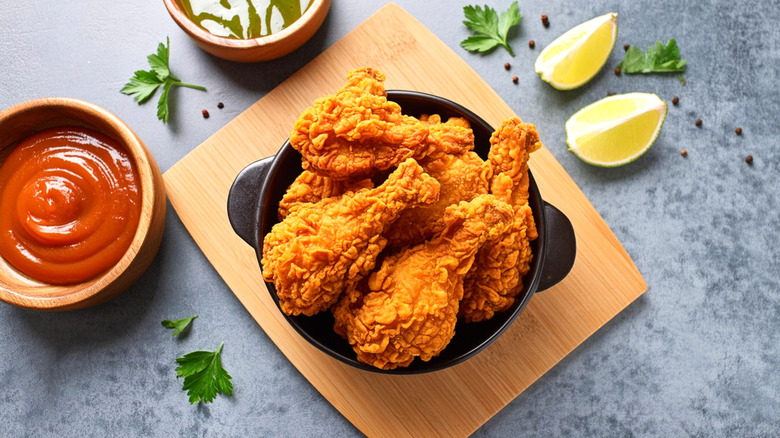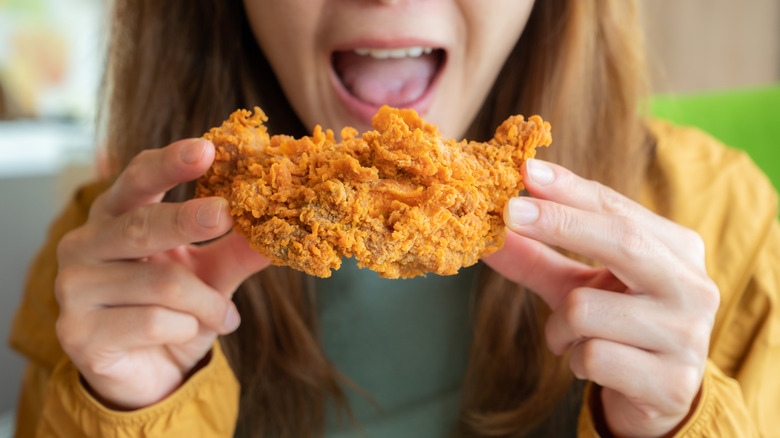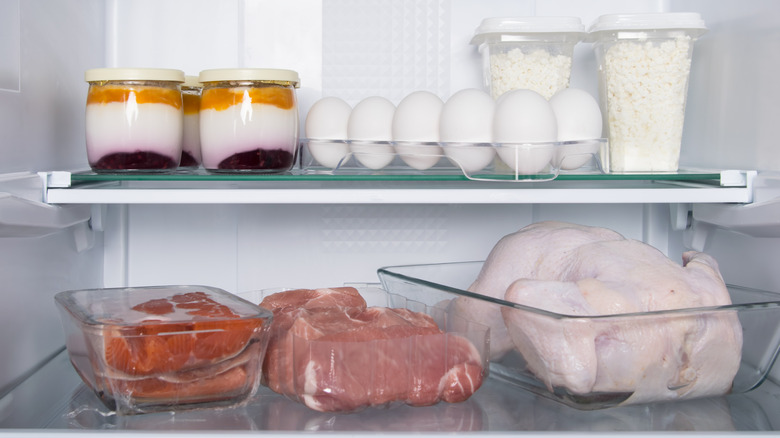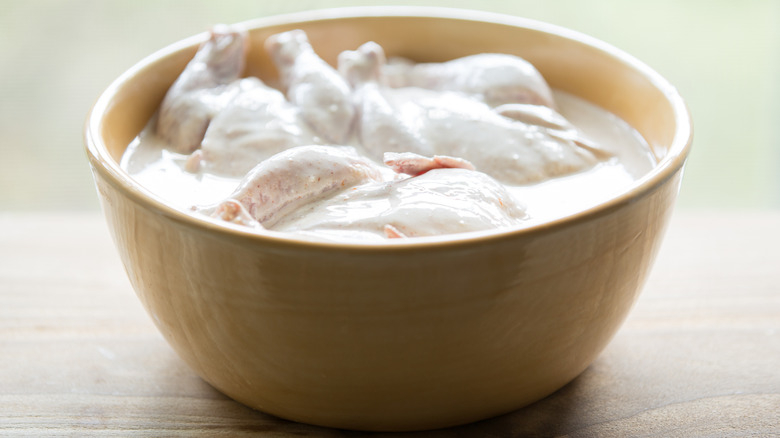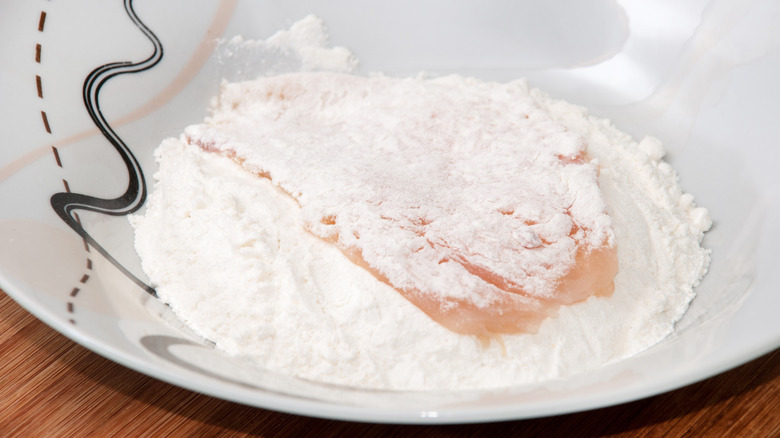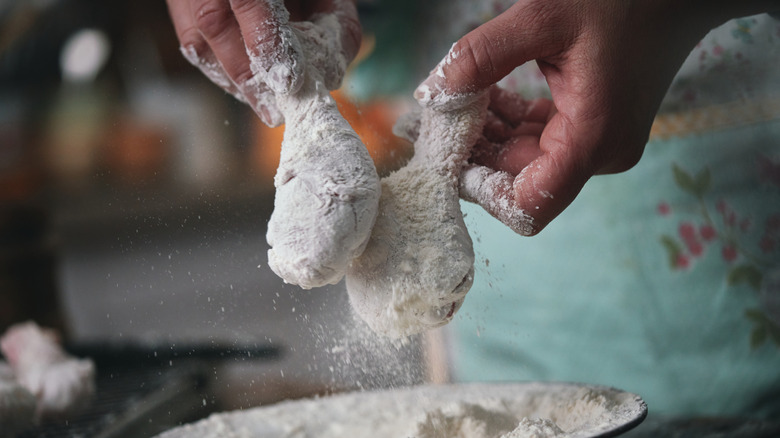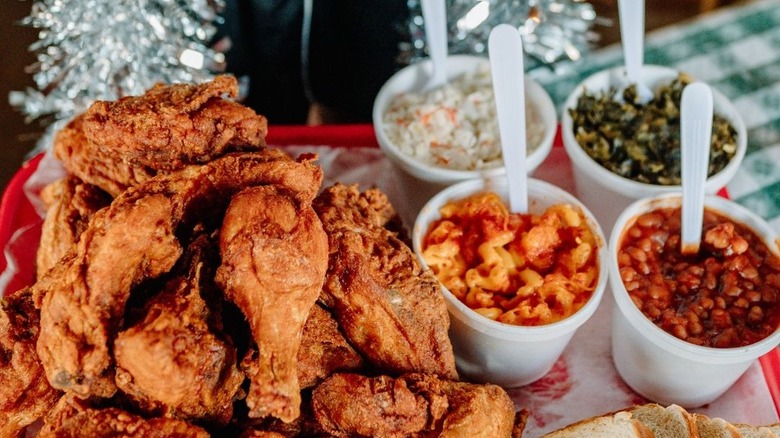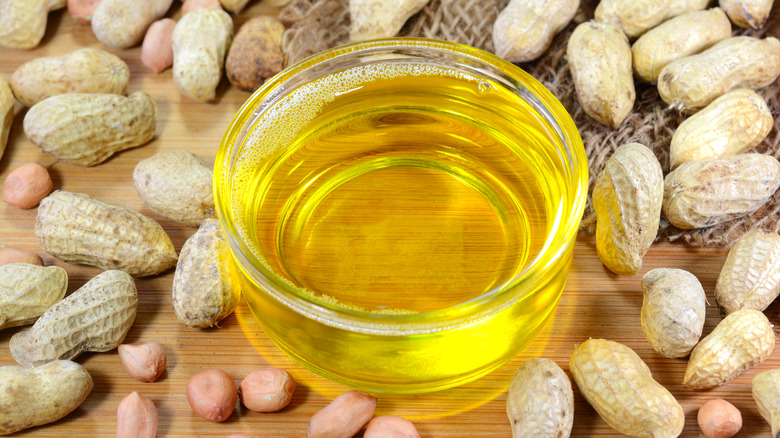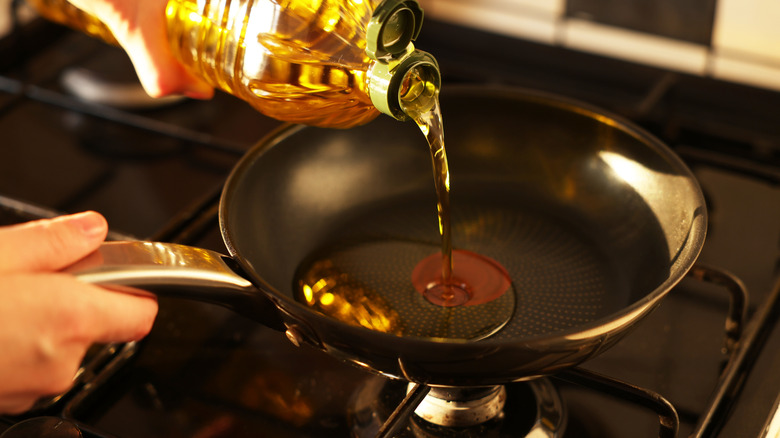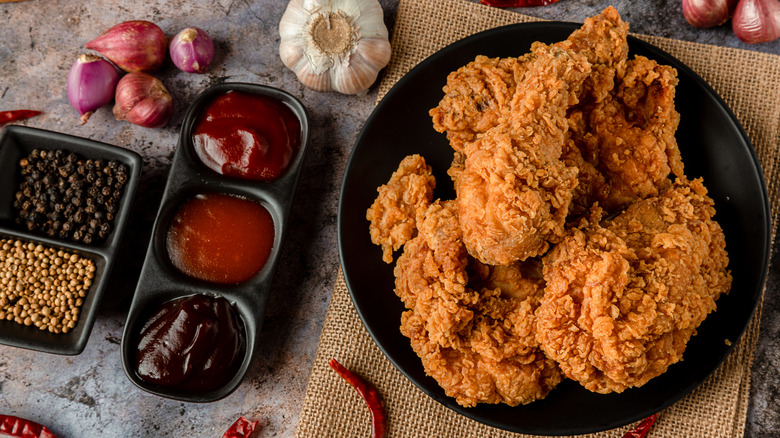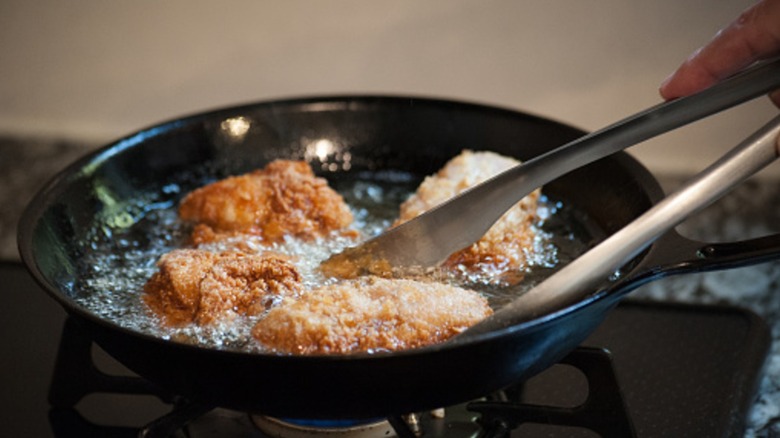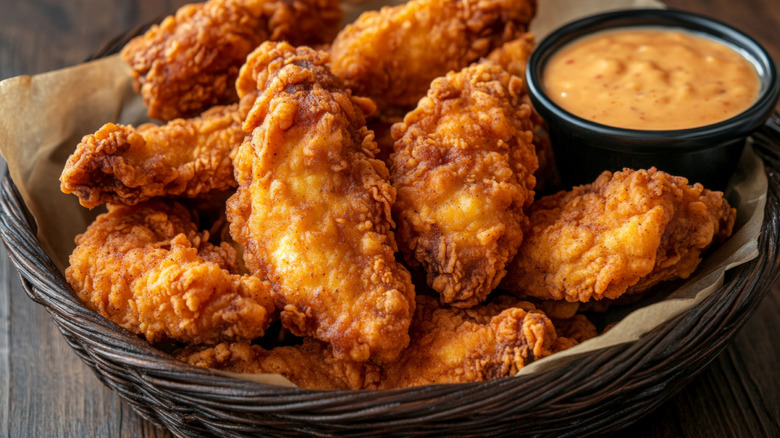11 Expert Tips For Making The Crispiest Fried Chicken You've Ever Tasted
We may receive a commission on purchases made from links.
Preparing fried chicken is a deeply personal process. Nearly any chef or cook that regularly prepares the crispy dish will have a very specific perspective on just how to make this beloved crispy food. The process, on the surface, is simple: Dredge chicken with seasoned flour, coat with egg mixture, and fry. Of course, each step has its own nuances and the preparation process also has its own special considerations.
We wanted to know some of the best tips chefs could offer, so we asked a few experts to share their thoughts on fried chicken and how best to prepare quality fried chicken. We caught up with Ian Scott, head chef at The Slogar, Wendy McCrory, president of Gus's World Famous Fried Chicken, and Adam Carry, chef at Picnic Provisions & Whiskey at the National Fried Chicken Festival. We also asked Chef Eric Huang, founder of Pecking House, to share his expertise when it comes to making delectable chicken. Collectively, these pro tips will help you create near restaurant quality fried chicken, even if it is made at home, right in your own kitchen.
Begin with your goals
Before trying out any new cooking task or recipe, it's helpful to keep your goals in mind. Understanding exactly what result you're working toward will help you achieve the most ideal results. Just as beauty is in the eye of the beholder, the ideal crunchy chicken will vary for all cooks. Like many, you're probably aiming for balance between moist chicken and crunchy breading with just the right amount of seasoning.
If you're not sure what those goals might be, as you've never made your own fried chicken, it's helpful to think about how you would describe your favorite fast food fried chicken chain. Is it a little on the soft side like Chick-fil-A, or is the crunchy breading more of a priority? Whatever your answer happens to be will drive the moves you make to create quality fried chicken from the most comfortable seat of all: your own table.
We asked Chef Eric Huang, self proclaimed "Fried Chicken Gang Lord," what his version of an ideal chicken would be. He described it as chicken with "a crispy crust, a juicy but not greasy bite and thorough seasoning." Basically, you're going for a balance of flavor and texture. The goal is to flavor the chicken so that you're not just biting into soft protein and to create a crust that has a satisfying crunch that easily reveals a juicy bite within.
Allow chicken time to dry
When frying your chicken, you may be eager to free the chicken from its wrappings and begin diving right into your marinating process. Who could really blame you? After all, there's a promise of fried chicken afoot. Before you do, you'll want to prepare the chicken, but it might not be in the way you expect. In fact, it'll involve the worst part of any recipe: waiting.
Chef Eric Huang recommends taking some extra time to allow your chicken to air dry. Remove the chicken from its wrapping and place it on a plate. Then, leave it in your refrigerator for roughly one evening. Huang explains why this step is necessary: "Due to the horrors of industrialized animal husbandry, mass-produced chicken encounters a disconcerting amount of water. And water is the enemy of all things crispy." Allowing your chicken some time to chill, undressed, will help remove some of that problem causing water.
While we love this tip, you may need to set a reminder for yourself. If you're anything like us, remembering to get your chicken out of the refrigerator in a timely manner could prove challenging, so setting a reminder on your phone or in your calendar would be a pro move here. As a result of this extra sitting time, you'll also want to pay attention to expiration dates at the grocery store and leave your chicken enough chilling time to dry out, well within your expiration window. Of course, if you're defrosting chicken, you'll need to plan even further in advance. Give your chicken enough time to defrost in the refrigerator and then an additional evening to dry.
Consider marination time
After you finish drying out the water from your chicken, consider marinating. It might not be the way everyone prepares their chicken, but a great marinade can help your meat have flavor right along with the crunchy fried coating.
Buttermilk style marinations create an ultra juicy bite and will take homemade fried chicken to the next level. Chef Eric Huang shares that "allowing for ample marination time" is one of the most important aspects of marination. You'll need to give the marinade time to do its job, so just as you made time for drying out chicken, make time to marinade. It may seem strange that you're drying out your chicken in one step and then replacing that liquid with another, but marinade will taste infinitely better in this process than the water.
If you're not convinced yet, Huang discusses his marination process as though it's something out of a wizard's spell book: "Our marination step allows the buttermilk to work its magic to give us a juicy, tender chicken." To help the process along and create an even better attachment to breading, Huang explains that he adds "a small bit of flour in the marination stage. This allows the gluten in the flour to hydrate and form a lattice that improves the crusts' adherence to the meat." If you've struggled in the past to get your crispy fried coating to thoroughly envelope your chicken, this may help solve that issue.
Pay attention to your dredging process
After some work on the preparation of your chicken, it's finally time to actually cook it. The first step will be dredging to create that crunchy fried chicken you crave. Dredging is the coating of the chicken in flour — or sometimes breadcrumbs — that you've seasoned before moving it through an egg mixture. The best flour to use when cooking homemade fried chicken may be rice flour, which performs even better than all purpose flour.
One of the troubles with dredging, especially if you're dredging multiple times, is that your flour or breading can get clumpy. Chef Ian Scott, co-owner of The Slogar out of Crested Butte, Colorado, explains that doing a "constant sift in between your dredging" will help ensure that clumping doesn't happen. Those clumps can become lumpy crunchy bits that could also burn and lead to less of an enjoyable bite. Scott adds that "sifting removes any of the excess buttermilk... That gives it that nice, crispy outer layer."
When building up that crunch coating, Chef Eric Huang encourages us to take the time to ensure that we achieve a "completely even coverage of dry flour just before frying." This way, all parts of the chicken achieve flavor. To be sure you get all the chicken, it might be tempting to leave it in the flour, but letting your chicken sit can also cause problems. Scott explains that allowing your chicken to sit too long in the flour may lead to a soggy bite, the opposite of crunchy chicken.
Toss about your chicken
When we picture the dredging process, it has seemed sufficient to move the chicken a small amount, flipping one or two times, but Chef Adam Carry has an entirely different recommendation. In fact, that chicken should be moved around quite a bit.
Instead of flipping once or twice, Carry explains that when dredging between flour and batter, you'll want to "toss the chicken at least 20 to 30 times to get those nice, crispy edges and little bits." That might sound excessive, but as soon as you get the chicken flipping about, it won't seem as overkill. Besides, a majority of your chicken will be covered by the end of the first few flips. After that, you're going to really create texture. Carry believes that "If you don't move the flour around, at the end, there's no nooks and crannies." Of course, after you flip about your chicken, please take time to pause and sift your flour.
Use wet batter
If you don't love the idea of using breading, there is an alternative. Wendy McCrory, president of Gus's World Famous Fried Chicken (a winner at the National Fried Chicken Festival), recommends a wet batter. She says that, "Most fried chicken companies use breading" and explains that the dry batter many restaurants use "absorbs the oils and will break down the exteriors." Alternatively, she reveals that using wet batter "creates a seal" on the chicken. This seal means that the chicken remains juicy and the coating gets that fried and crispy exterior.
It's pretty easy to identify a wet or dry battered piece of chicken. If you notice a high textured piece of chicken that is very bumpy, it's no doubt dry battered. On the other hand, if your chicken is rather smooth looking and has a pretty consistent texture, it's more than likely wet battered. Another good indicator, as McCrory says, is if the chicken is especially moist and juicy within, you're probably dealing with a wet-battered chicken, owing to the fact that batter was able to create a seal to the chicken.
Select your fry oil wisely
For some, the prospect of frying food is more than a little intimidating. There's so many decisions to make, and one of the more easily forgotten ones is specifically what kind of oil you will use. Of course, there are plenty of options, but of the experts we talked to, it seems peanut oil is the winner.
If you or people you are eating with have allergies to peanuts, you'll obviously want to avoid peanut oil. But if allergies aren't a concern, it's an ideal option. Wendy McCrory recommended peanut oil because it "has a higher fry point." As a result, the oil won't have a "burnt taste to it" that could potentially leach over into your fried chicken. Although we're going for crispiness here, having a burnt flavor isn't going to fool anyone into thinking the chicken is extra crispy.
When preparing fried chicken, so many of the ways you can create a crispy bite has to do with different ingredients or techniques. It might be easy to forget that your oil could play a part in achieving this effect, as well. In fact, McCrory recommends using refined peanut oil because it adds to the overall crispiness of the chicken, not just because it won't lead to a burnt flavor.
Choose the right pan
When making a new dish or stepping into a new food category, it might feel like you're making decision after decision that feel only slightly informed. That's part of the reason that expert opinions are so very helpful. Especially if you're new to frying chicken, you might be a little nervous about the oil involved and how it will behave in the pan. So you might be tempted to choose a large stock pot for protection or even a pan that is too small. Neither one of these choices is optimal.
Instead, Wendy McCrory says that she likes to use a 6 or 8-inch pan. That might seem a little bit on the small side, but if you choose one with some amount of wall to protect from potential splatter, it makes for the perfect amount of room for fried chicken. This way, you'll be able to get as many pieces of chicken in the pan to feel like you are churning through what you need to cook, but you won't be tempted to overcrowd the pan and create a subpar chicken experience.
That said, options are always nice, and the right pan for one person may not be your ideal pan. That's why we love investing in a set. If you're short on space, Calphalon makes a great 10-piece set that includes an 8-inch fry pan, and to conserve shelf space, everything stacks neatly on top of one another.
Heat oil to a Goldilocks zone
Using the right oil for your diners to achieve that desired chicken texture is an important choice, but how hot you decide to heat that oil is going to dictate a whole lot about your chicken, too. Those new to the fried chicken world might feel a little uncomfortable with heating up the oil too much. Wendy McCrory offers a great indicator: "If your oil is smoking, it's too high." If you get to that smokey level, take some time to have it cool down. Checking temperature, McCrory says that your oil should be around 350 F. For reference, the smoke point for peanut oil is 440 F to 450 F, so if your peanut oil is smoking, you're way over your goal temperature.
Of course, not everyone agrees on the specific temperature that your oil should achieve. Chef Eric Huang, for instance, explains that 325 F "is really the Goldilocks Zone for frying chicken and being able to keep the oil at that temperature will generally assure juicy, cooked chicken with a golden brown and crispy crust." You'll notice that 325 F is cooler than McCrory's recommended 350 F, but like so many aspects of cooking, there's going to be a fair amount of trial and error to find that Goldilocks zone for yourself. You'll want the temperature to be high enough that it crisps up the breading or coating and will still cook the chicken thoroughly.
Be mindful of oil getting too cold
While Goldilocks never had to worry about the actual effects of too cold porridge, you're definitely going to need to worry about the effects of too cold oil. Chef Eric Huang states that "If the oil is too cold, oil will permeate the crust before the water can evaporate quickly enough to expel it." This could lead to chicken with a poor texture. The good news is if you notice your oil getting too cold, you can simply heat it up a little bit more. Patience is key.
The temperature of your cooking oil might feel like a minor detail, but Huang notes that it is one of the most important factors. Once you achieve the ideal cooking oil temperature, maintaining it so it creates a constant temperature takes a little bit of trial and error, but with continued efforts, you'll find the perfect balance. So much can impact the way that food cooks in a given environment, so it's important to figure out what works best for you and your own kitchen.
Cook chicken past 165 F
If you're anything like us, you keep an instant read thermometer nearby, especially when cooking meat, so as you're trying to find that perfect oil temperature, be sure to check your fried chicken for doneness. With chicken, you're no doubt accustomed to searching for that 165 F doneness point, but Wendy McCrory states that at Gus's World Famous Fried Chicken, "We cook our chicken past 165 F." For a visual indicator, McCrory says, "We wait until the chicken is floating in the oil, and then we know it's cooked." We like this tip because it makes it very difficult to go overboard on cooking. Especially if fried chicken is new territory for you, having a visual indication of when it might be complete is always handy.
Floating isn't the only visual cue to know that your chicken has reached its ideal temperature. Chef Adam Carry looks at the color of the breading. He says, "We're looking for a ruddy, reddish golden." When it reaches this ideal color, the chicken is pulled. He adds, "You don't want too much more than that because you'll burn out the flavor." Overcooking your chicken can certainly lead to a piece that is difficult to eat and just tastes like burnt and dried out fried bits. While undercooked chicken is dangerous, overcooked chicken is unappetizing for completely different reasons. Mainly, it's almost impossible to eat.

